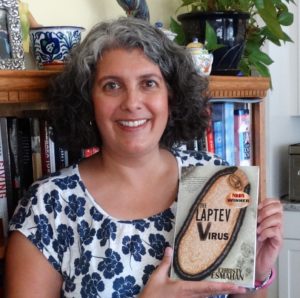NPR’s Michaeleen Doucleff reported in the news this morning that “an outbreak in Russia is thought to be a result of thawing permafrost.” This time it is a bacterial strain called Anthrax. You may remember that this microbial bad guy was als o associated with postal terrorism around the time of 9/11, in which several people received envelopes with deadly anthrax spores.
o associated with postal terrorism around the time of 9/11, in which several people received envelopes with deadly anthrax spores.
Let’s talk about bacteria. They come in several basic shapes: little round balls called “coccus” (pl. “cocci”), elongated hot-dog shapes called bacillus (not to be confused with the bacterial genus called Bacillus), wavy or cork-screw shaped ones called spirillum or spirochaete (respectively) and comma-shaped, called vibrio. If the bacteria naturally group themselves into clumps or clusters, we call them staph (it’s no surprise that Staphylococci look like a clump of grapes under the microscope) and if they are in chains, they are called strept.
But back to Anthrax. Its scientific name is Bacillus anthracis, and its natural environment is the soil. When the soil is moist and fertile, the bacteria grow and reproduce happily, causing no real harm to anyone. However, when there is a crisis in their environment and they don’t have enough nutrients or water to continue reproducing well, they form spores. You can think of spores almost like very primitive seeds or time capsules. When the going gets rough, each bacterial cell makes several copies of its DNA and wraps them tightly in multiple layers of proteins that can protect them from harsh conditions such as drought, ice, heat, etc.
Many bacteria, especially bacillus-shaped ones, can create spores, but what makes anthrax unique is how much energy and time they dedicate to the process. According to Science Daily, Dr. Scott N. Peterson at The Institute of Genomic Research in Ann Arbor, MI, helped to discover many of the genes involved in this process and if you are interested, it’s fascinating reading. But what it basically boils down to is that anthrax is really, really good at making spores that last a long time under harsh conditions.
The other advantage that spores have is that they are very, very tiny. A bacterial cell appears smaller than the period on this sentence when viewed under 1000 times magnification and spores are even tinier. Anthrax spores can easily be carried on the wind to (as the bacteria would wish if they could do such a thing) greener pastures where their offspring could live and grow happily.
When a spore senses that it is indeed in a friendlier environment, (a process that can take up to 60 days) it becomes activated and grows into new bacteria. Animals who put their faces down to the ground to eat (think cattle, sheep, deer, etc.) can become infected with anthrax spores. Anthrax bacteria are not always pathogens (making people or animals ill like Streptococcus or Vibrio genre of bacteria are) but they are opportunists. If given the chance to grow on a warm body, eating up its rich tissues, they take it. And they don’t much care whether that body belongs to a cow, a reindeer or a human.
Now, as grim as this all sounds, the incidence of humans becoming ill with “environmental” (i.e. non-terrorist released) anthrax is really not that common. That’s why the news of dozens of people hospitalized and one person dying from anthrax is a big deal. In this case, scientists found that several thousand reindeer had been infected first, and then they started investigating how those reindeer got sick. It looks like the culprit could be a reindeer that died from anthrax many decades ago and then got covered in frost. Its corpse (containing millions and millions of tiny anthrax spores) eventually became part of the permafrost.
Enter global climate change, permafrost melting and suddenly millions of little anthrax spores which are, once again, free to move into the environment where they can happily reproduce, and you have a recipe for disaster.
According to Dr. Jean-Michel Claverie, a researcher who works at the National Center for Scientific Research in France, and who very kindly corresponded with me as I was preparing to publish The Laptev Virus, providing me with the photograph on the cover of the novel, this kind of thing is going to happen more and more often. He and his team have discovered at least two viruses which have spent thousands of years frozen and are still viable. In addition, he predicts that more human pathogens remain to be found.
So, stay tuned and if you see any dead reindeer, yeah, don’t go there!
If you liked this article, I hope you will pick up a copy of my award-winning novel, The Laptev Virus. It begins in the Arctic where an unsuspecting oil company accidentally discovers a virus that was frozen for 30,000 years in the permafrost, and turns out to be a viable pathogen. Researcher Sarah Spallanzani and her team work as medical detectives to try to find a way to stop the virus.



4 comments
Skip to comment form
I’m a science freak, so I absolutely love your book (still reading it), but what happened to Sarah’s ankle? I keep waiting for an explanatio!
Author
Dear Noreen,
This is Sarah Spallanzani–Christy told me that you were concerned about my ankle–thank you, that is so kind! As you know, I live in Houston and we have a lot of rain here, not counting tropical storms or hurricanes, so the city has some pretty deep storm drains. I was crossing the street from Hermann Park, heading back to my office, and was lost in thought (as usual) when I accidentally stepped down into one of these low drains and badly twisted my ankle. I wasn’t going to go to the doctor, but when John saw the bruising and swelling, he insisted, and it turned out that I had a bimalleolar fracture, which includes the tibia and the fibula. (All right, Christy is telling me that this is far more detail than you probably expected–my apologies! But you said you loved science and I sensed a kindred soul!) Anyway, this happened right before the adventures of The Laptev Virus began so I was still healing during the narrative. I’m all better now, though, and on to my next adventure, which Christy is promising to publish soon. I hope you’ll follow me there as well. And thanks again for your concern!
All the best,
Sarah
Wow! You explain that so well!
Author
Thank you! That was my intention! 😉